2016 Calling Protocols & Disposition
Attachment 10a-Calling Protocols and Dispostion.docx
Behavioral Risk Factor Surveillance System (BRFSS)
2016 Calling Protocols & Disposition
OMB: 0920-1061
Attachment 10a-2016:
BRFSS Data Collection Protocol with
Disposition Table


Table of Contents
State Pilot Projects Using Protocol Adjustments 14
Appendix A: BRFSS Core Questionnaire (Draft) 15
Appendix B: Disposition Table with Callback Rules 17
Appendix C: Understanding Coding for Technological / Telecommunication Barriers 36
Appendix D: Uploading BRFSS Data Using OneEdits 43
Introduction
In 1984, the Centers for Disease
Control and Prevention (CDC) initiated the state-based Behavioral
Risk Factor Surveillance System (BRFSS)—a cross-sectional
telephone survey that state health departments conduct monthly over
landline telephones and, since 2011, cell phones; the states conduct
the BRFSS survey with the use of a standardized questionnaire and the
technical and methodologic assistance from CDC. BRFSS collects
prevalence data among noninstitutionalized adult US residents
regarding their risk behaviors and preventive health practices that
can affect their health. Respondent data are forwarded to CDC to be
aggregated for each state, returned with standard tabulations, and
published at year's end by each state. In 2014, over 400,000
interviews were conducted in the states, the District of Columbia,
and participating US territories and other geographic areas.
This
document provides data collectors with a BRFSS overview and outlines
the processes involved with calling, disposition-code assignment, and
data submission. This document does not cover details of sampling and
weighting, as they are not data-collectors’ responsibility.
Specific information regarding data quality, response and/or
cooperation rates, or calling outcome can be found in the yearly
Summary Data Quality Report released with the annual data set.
Find
yearly data and support documents here:
http://www.cdc.gov/brfss/data_documentation/index.htm.
Details of the data collection process are discussed in regularly scheduled conference calls and at the annual BRFSS meetings/training workshops. BRFSS encourages data collectors to participate in these events, as updating BRFSS data-collection protocol is a collective process that is strengthened when organizations and day-to-day stakeholders provide their input.
The BRFSS
Process
The BRFSS questionnaire was developed in collaboration with CDC and public health departments in each of the states, the District of Columbia, and participating territories. Data derived from the questionnaire provide health departments, public health officials, and policy makers with behavioral and health status information that, when combined with mortality and morbidity statistics, guide the development of health-related policies and priorities as well as help decision makers address and assess strategies to promote good health. A finalized version of the questionnaire is sent to the states each year. CDC also provides computer-assisted telephone interviewing (CATI) programming to states, but they may opt to use their own CATI programming software and can refer to the final version of the BRFSS questionnaire as a guide. States may not change the skip patterns or wording of questions in the questionnaire but are free to create state-added questions that can be customized to states’ individual needs (see below). In some instances, states may insert state-added questions into the questionnaire--with permission from CDC--when such questions fit into the context of extant topics/sections and do not impede the flow of the interview. Requests should be submitted to the state project officer or the survey methodologist on the Survey Operations Team.
Annual questionnaire construction
The BRFSS questionnaire comprises an annual standard core, which includes questions asked of respondents each year; a biannual rotating core, which includes questions asked only in even- or odd-numbered years; optional modules, which include standardized questions adopted verbatim by the states; and state-added questions, which states individually customized. Appendix A provides a draft copy of the 2016 BRFSS questionnaire, including modules with skip patterns. Data collectors will note that the 2016 questionnaire includes skip patterns for landline and cell phone interviews that administrators should follow when they are conducting interviews using a sample provided by CDC (see Sampling below).
Standard Core Questions: The portion of the questionnaire that is included each year and must be asked by all states. The core may include questions about emerging or “late-breaking” health issues. After 1 year, these questions are either discontinued or incorporated back into the standard core or become part of the rotating core or optional modules.
Rotating
Core Questions: The
portion of the questionnaire asked by all states on an
every-other-year basis. These questions regularly appear in even- and
odd-numbered years.
Optional
Modules:
Optional modules are sets of standardized questions on various topics
that each state may select and include in its questionnaire. Once
selected, a module must be used in its entirety and asked of all
eligible respondents. If an optional module is modified in any way
(e.g., if a question is omitted), then the questions will be treated
as state-added questions (see below).
In order to achieve a wide range of data, states may choose to “split” samples in order to give different modules to each smaller group of participants. For example, if a state adopts a questionnaire that is too long to ensure respondent cooperation, a greater number of modules may be used if the state gives different ones to groups of 2,500 or more respondents. Some respondents, therefore, will answer the core questionnaire and one set of modules, while others answer the core questionnaire and a different set of modules. States are required to conduct at least 2,500 interviews for each of the versions of the questionnaire in order to have enough responses for weighting purposes. States create different questionnaire versions when they split modules among respondents. States may adopt up to three versions of the questionnaire, each including the core (with standard and rotating core questions) and a specified number of modules, which will differ by version. States must include modules on both landline and cell phone interviews. Versions must also be included in both samples.
State-added Questions: BRFSS encourages states to add their own extra questions to their questionnaire, so they can gather data on additional topics related to their specific health priorities. All questions included in the BRFSS, with the exception of state-added questions, are cognitively tested prior to inclusion in the questionnaire. It is up to each state to decide whether or not it will cognitively test its state-added questions before use. State-added questions may not be inserted into the text of the core questionnaire or optional modules without approval from BRFSS. States should contact their project officers to request insertion of state-added questions into text that has been approved for use by all states.
The wording of the questions in any part of the BRFSS, with the exception of state-added questions, is determined at the annual BRFSS meeting in March, where BRFSS state coordinators vote to adopt questions submitted by CDC programs. A governing group including state BRFSS coordinators, CDC staff and others known as the BRFSS Working Group, may add questions on emerging issues (such as the H1N1 flu questions added in 2009). After the BRFSS meeting, CDC then designs core components and optional modules and produces data processing layouts, while considering state priorities, potential funding, and other practical aspects. A field test of new portions of the BRFSS questionnaire will be conducted according to the results of voting. Minor changes in question wording and format may be made after the field test. The new BRFSS materials for the next surveillance year are then sent to the states, which may add their own questions that they have designed or acquired. A target of October 1 is set for finalization of the questionnaire for the upcoming year.
Data collectors should have the capacity to make modifications, including addition of questions, during the course of the year. In addition, data collectors must be capable of adjusting screening questions that determine eligibility during the course of the year.
Data Collection
Data collection follows a suggested BRFSS interviewing schedule; all calls for a given survey month should be completed in the same sample month if possible. In some cases samples begun in one month may be completed in the first 7-10 days of the next month. Up to 15 calling attempts may be made for each landline phone number and up to 8 for each cell phone number in the sample, depending on state regulations for calling and outcomes of previous calling attempts. Although states have some flexibility in distribution of calling times, in general, surveys are conducted using the following calling occasions:
Conduct 20% of landline calling attempts on weekdays (before 5:00 PM)
Conduct 80% of landline calling attempts on weeknights (after 5:00 PM) and weekends
Conduct cell phone calling attempts during all three calling occasions (weekday, weeknight, and weekend), with approximately 30% on weekend calling occasions.
Change schedules to accommodate holidays and special events.
Make weeknight calls after 5:00 PM.
Adhere to respondents’ requests for specific callback/appointment times whenever possible.
Data collectors must develop and maintain procedures to ensure respondents’ confidentiality, assure and document the quality of the interviewing process, and supervise and monitor the interviewers.
Each telephone number in the CDC-provided sample must be assigned a final disposition code to describe the result of calling the number:
A completed or partially completed interview (see definitions in Appendix B) or
A determination that:
A household was eligible to be included but an interview was not completed or
A telephone number was ineligible or could not have its eligibility determined.
The final disposition codes are then used to calculate response rates, cooperation rates, and refusal rates. The distribution of individual disposition codes and the rates of cooperation, refusal, and response are published annually in the Summary Data Quality Reports. BRFSS uses standards set by the American Association of Public Opinion Research (AAPOR) to determine disposition codes and response rates. All BRFSS disposition codes and rules for assigning disposition codes are provided in Appendix B: Disposition Table with Callback Rules. Given the myriad outcomes for assigning specific codes associated with technological barriers, additional guidance is provided in Appendix C: Understanding Coding for Technological/ Telecommunication Barriers. Data collectors must follow the rules for assigning disposition codes and train and monitor interviewers in the use of specific dispositions.
Survey Protocol
BRFSS sets standard protocols for data collection, in order to maintain consistency across states that permits state-to-state data comparison. Data collectors should follow the assignment of disposition codes provided in Appendix B: Disposition Table with Callback Rules. Disposition codes follow the format of 1000-1999 completed/partially completed; 2000-2999 non-completed interviews with eligible respondents/households; 3000-3999 non-completed interviews with unknown eligible persons/households; 4000-4999 ineligible numbers; 5000-5999 interim dispositions. A 2000 level disposition should not be assigned unless the interviewer is certain that both the household and respondent are eligible for the survey. Assigning incorrect disposition codes can lower response rates and efficient use of the sample. The following items are included in the BRFSS survey protocol:
1. All states must include the core questions and introductory scripts without modification. States may choose to add any, all, or none of the optional modules and state-added questions after the core component. Interviewers may not offer information to respondents on the meaning of questions, words, or phrases beyond the interviewer instructions provided by CDC and/or the state BRFSS coordinators. States may not insert state-added questions into the core component or into optional modules without permission. State coordinators should contact their CDC project officers to request the placement of state-added questions into text that has been approved for use by all states.
2. Systematic, unobtrusive electronic monitoring is a routine and integral part of monthly survey procedures for all interviewers. States may also use callback verification procedures to ensure data quality. Unless supervisory monitoring of 10% of all interviews is being routinely conducted, a 5% random sample of each month’s interviews must be called back to verify selected responses for quality assurance. Recording calls as part of quality assurance is not part of the BRFSS methodology and recording interviews without respondent knowledge is not legal in all states. Data collectors should remember that cell phone numbers may reach respondents in any state or country, where laws on recording calls may be different than in the state where the call originated.
3. An eligible household is defined as a housing unit that has a separate entrance, where occupants eat separately from other persons on the property, and that is occupied by its members as their principal or secondary place of residence. The following are non-eligible households: vacation homes not occupied by household members for more than 30 consecutive days per year, group homes, institutions, and (in the landline telephone sample) households in states other than the one conducting the BRFSS questionnaire. Persons in a state’s cell phone sample who are residents of other states are eligible for interview. The state contacting the respondent should complete the core questionnaire and then provide the data to CDC for transfer to the appropriate state of the respondents’ residence. Since 2012, persons living in college housing have been included as eligible respondents. Although it is rare to contact a college housing resident in the landline sample, this person would also be included as a single adult household. The BRFSS is a self-reported survey. If respondents report that they live in private residences, it is not the role of interviewers to question them. The only instances under which there is discuss of information on whether households qualify as private residences is when respondents initiates the question.
4. Eligible household members include all related adults (aged 18 years or older), unrelated adults, boarders/roomers, live-in au pairs or students and domestic workers who consider the household their home, even though they may not be home at the time of the call. College housing residents are treated as single adult households. Household members do not include adult family members who are currently living elsewhere.
5. Questions should be read verbatim. In many cases introductory phrases are provided which should also be read as written. Interviewer instructions are optional and can be read if the respondent is confused or needs additional information. Items in parentheses in statements are also optional and may be read for clarification. Interviewers should not offer their own interpretation of questions or response options.
6. Proxy interviews are not conducted in the BRFSS. For people interviewed on landline telephones, individual respondents are randomly selected from all adults living in a household and are interviewed in accordance with BRFSS protocol. Household members include all family members, domestic servants, and au pair or live-in students who have resided at the residence for at least 3 months. Cell phone interviews are conducted with respondents who answer the number called and are treated as one-person households.
7. An interview is considered complete if data are collected for all questions which would have normally been asked for any selected respondent. Partially completed interviews are defined as those where the first sections of the interview are completed and the portions of the demographic section which are used for weighting are also asked of the selected respondent in regular order of the questionnaire. For 2016, this would take the respondent through question 8.8. If the respondent does not provide substantive responses for weighting variables (that is, the respondent refuses to answer or responds that he/she does not know), imputed values will be generated and used only to assign weights.
8. With the exception of verbally abusive respondents, eligible people who initially refuse to be interviewed may be contacted at least one additional time and given the opportunity to be interviewed. Preferably, this second contact will be made by a supervisor or a different interviewer. Some states have regulations on whether refusals should be called again and the manner of the refusal conversion. For example, a period of two days between the initial refusal and second attempt is often standard protocol. Data collectors should contact the state BRFSS coordinator to determine the state’s policy on calling back refusals.
9. States are required to give a final disposition for every number in the sample, usually within the same month of the sample. States should complete all calling on each monthly sample within that month. A few states receive and account for all calling on a sample on a quarterly basis rather than a monthly basis. Data collectors should contact the state BRFSS coordinator to verify whether the state is receiving a monthly or quarterly sample from CDC.
10. The BRFSS OMB number and burden statement must appear on the header page of all interviewer forms. The CDC will provide the header with the questionnaire each year. Please note that the interviewers do not need to read any part of the OMB number or burden statement to the respondents unless asked. The entire burden statement does not need to be read if the respondent is simply asking how long the interview will take. If the respondent asks for any information at any time about the authority by which information is being collected, it is imperative that the OMB approval information be available to the interviewer. The interviewer may then cite the OMB control information, which would allow the respondent to review the project plan online.
General callback and disposition coding rules are established by CDC (see Appendix B), and states are encouraged to adhere to them whenever possible. The calling rules are not universally applicable to each state. Data collectors contracted by the states should have the capacity to adhere to the calling rules listed below as well as those to in Appendix B.
All cell phone numbers must be hand dialed. New rulings by the FCC have called into question some previously standard practices of previewing numbers. Data collectors should seek legal advice if they are uncertain whether their practices are in any way contradictory to the new regulations. Note that the definition of an autodialer has expanded as of June 2015 to include any phone that is connected to another device that can store or redial a data base of numbers. Therefore, at this writing, data collectors should disconnect their phones used to manually dial cell samples from computer systems that have this capability. Refer to current TCPA regulations and interpretations on this issue. This is a fluid interpretation and new regulations may be in place soon. Hand dialing alone is not sufficient to comply with these regulations. Federal surveys are not exempt from the TCPA regulations.
Interviewers should be trained specifically for the BRFSS and retrained each year.
If possible, calls made to non-English-speaking households and assigned the interim disposition code of 5330 (household language barrier) should be attempted again with an interviewer who is fluent in the household language (e.g., Spanish).
States should maximize calling attempts as outlined in Appendix B. The maximum number of attempts (15 for landline telephone and 8 for cell phone) may be exceeded if formal appointments are made with potential respondents.
Calling attempts should allow for a minimum of 6 rings and up to 10 rings if not answered or diverted to answering devices.
The maximum number of attempts may be set by the states. CDC recommendations for the minimum number of attempts are 15 for landlines and 8 for cell phones.
All numbers must be assigned a final disposition. Data should not be submitted with interim dispositions.
Messages left on answering devices/voice mail devices should be left by interviewers. Messages should never be left by any automated voice devices. States may have their own standard scripts for messages, describing the reasons for the call and when respondents might expect a return call. Messages can be left after any attempt. It is not recommended that respondents be burdened by repeated messages. States should adopt protocols to leave one or two messages during the calling attempts for a single number during the calling period.
Using the BRFSS Sample
In some instances, states design samples within boundaries of sub-state geographic regions. States may determine that they would like to sample by county, public health district, or other sub-state geography in order to make comparisons of geographic areas with their states. To conduct the BRFSS, states get samples of telephone numbers from CDC. States then review their sampling methodology with a state statistician and CDC to make sure data collection procedures are in place to follow the methodology. States must consult with CDC before making changes to methodology. States must maintain sample phone numbers in files that are separate from responses, in order to maintain standards of respondent confidentiality.
The BRFSS uses two samples: one for landline telephone respondents and one for cell phone respondents. State BRFSS coordinators work with CDC to produce all samples The CDC recommends that the range of completed cell phone interviews be a minimum of 35% to a maximum of 65% of total complete interviews. The 35-65% range of cell phone interviews is set to ensure the geographic distribution of the sample (since landlines samples can be geographically distributed across the state) and to ensure that the sample is demographically representative of the state. Since landline telephones are often shared, household sampling is used in the landline telephone sample. Household sampling requires interviewers to collect information on the number of adults living in a residence and then select randomly from all eligible adults (see questionnaire). Cell phone respondents are treated as single adult households and therefore do not require household sampling. The samples are fully overlapping, so that any eligible person in the landline frame may also be eligible in the cell phone frame. States receive the sample monthly or quarterly, approximately by the 15th. Note that the BRFSS is a sample with replacement. It is possible, therefore, for a single household/respondent to be eligible and appear in a sample more than once within a year. Some states eliminate duplicate (“de-dup”) numbers that appear within the same quarter. A state with sub state regions that represent small area is more likely to encounter repeat numbers in the sample. States that wish to send advance letters should request addresses with their regular landline sample. For states that send advance letters, mailing addresses are appended to landline telephone numbers. Addresses may not be attached to cell phone samples. Data collections should release all replicates (of 30 numbers) in the sample in the first week of each month. The table below provides the format for the landline and cell phone sample files received by the states.
Field Name |
Size |
Position |
Format/Values/Explanation |
|
||||||||||
Phone Number (AREACODS, PREFIXS, SUFFIXS) |
22 |
1-22 |
9,1-NNN-NNN-NNNNv20161 |
|
||||||||||
Geographic Stratum (_GEOSTRS) |
3 |
23-25 |
First position = 1 for Landline / 2= Cell phone Then States with no geographic strata=01 in each record. Others according to provided information. |
|
||||||||||
Density Stratum (_DENST2S) |
1 |
26 |
1=Listed number, 2=Not listed one-plus block, 3=Zero block, 9=Not applicable (GU, PR, VI). |
|
||||||||||
Sequence Number (SEQNO) |
10 |
27-36 |
A unique 10-digit number for a state for a year with year in the first four digits. For example: 2015000001. |
|
||||||||||
Number of Records Selected From Stratum (NRECSELS) |
6 |
37-42 |
Number of telephone numbers (eligible sampling units) selected from stratum. |
|
||||||||||
Number of Records in Stratum (NRECSTRS) |
9 |
43-51 |
Number of telephone numbers in the stratum from which sample was selected. |
|
||||||||||
Precall [GENESYS-ID] Status (PRECALLS) Landline sample |
1 |
52 |
1=To be called, 3=Non-working number, 5=Business phone. (Including GU, PR, VI) 4 = Cellular – PRO-T-S, 6 = Cellular - Interviewer |
|
||||||||||
Precall [Cell-WINS Screening] Status (PRECALLS) Cell phone sample |
1 |
52 |
1=Active, 3=Inactive, 7=Unknown Status
|
|
||||||||||
Replicate Number (SMONTH, REPNUM) |
6 |
53-58 |
The first two digits, 01-12, represent months, the last four digits a sequential number starting with 0001 each month. |
|
||||||||||
Replicate Depth (REPDEPTH) |
2 |
59-60 |
A sequential number from 01‑30 in each replicate. |
|
||||||||||
State FIPS Code (_STATE) |
2 |
61-62 |
FIPS code of assigned state. |
|
||||||||||
County FIPS Code (ASGCNTY) |
3 |
63-65 |
FIPS code of assigned county. Blank=GU, PR, VI. |
|
||||||||||
County FIPS Code of Listed Number (LISTCNTY) |
3 |
66-68 |
For listed numbers, FIPS code of the county in which number is located. For not listed numbers=999. Blank=GU, PR, VI, and cell phone sample |
|
||||||||||
Number of Landline Assignments in 1K Blocks in Assigned County (NOHHCTY) |
4 |
69-72 |
Number of Landline Assignments in 1K Blocks that are in assigned county. Blank=GU, PR, VI, and cell phone sample |
|
||||||||||
NXX Type (NXXTYPE) |
2 |
73-74 |
Blank |
|
||||||||||
Number of Landline Assignments in 100 series bank (BLCKSIZE) |
3 |
75-77 |
Number of landline assignments in hundred block=000-100. Blank=GU, PR, VI, and cell phone sample |
|
||||||||||
Number of Landline Assignments in 1K Block (LSTHHPRE) |
5 |
78-82 |
Number of Landline Assignments in 1K Block Blank=GU, PR, VI, and cell phone sample |
|
||||||||||
Estimated Total Households in Prefix (TOTHHPRE) |
5 |
83-87 |
BLANK |
|
||||||||||
Core Based Statistical Area (CBSACODE) |
5 |
88-92 |
99999=Not in an MSA. Blank=GU, PR, VI, and cell phone sample |
|
||||||||||
Metropolitan Status Code (MSCODE) |
1 |
93 |
1=In the center city of an MSA, 2=Outside the center city of an MSA but inside the county containing the center city, 3=Inside a suburban county of the MSA, 4=In an MSA that has no center city, 5=Not in an MSA. Blank=GU, PR, VI. |
|
||||||||||
Rate Center Name (RCNAME) Cell phone only |
30 |
94-123 |
Rate Center Name (RCNAME) |
|
||||||||||
V&H Coordinate (VNHCOORD) |
10 |
124-133 |
BLANK |
|
||||||||||
Date Sample Generated (DATESMP) |
10 |
134-143 |
mm/dd/yyyy |
|
||||||||||
Pre-screening Process Used (PRESCREN) |
1 |
144 |
0= Not screened 1=ID 2=ID Plus 3 = CSS, 4 = Cell
|
|
||||||||||
Date Sample Pre-screened (DATESCRN) |
10 |
145-154 |
mm/dd/yyyy
|
|
||||||||||
Release Date of Active Prefix Database (PHNRLDAT) |
10 |
155-164 |
mm/dd/yyyy Blank= cell phone sample |
|
||||||||||
Release Date of Listed Phone Number Database (LSTRLDAT) |
10 |
165-174 |
mm/dd/yyyy Blank=GU, PR, VI, and cell phone sample. |
|
||||||||||
CLEC Number (CLEC) |
1 |
175 |
1=Yes, 2=No. Blank=GU, PR, VI, and cell phone sample. |
|
||||||||||
Replicate designated for inclusion in Multi-Mode Mail Survey and address match status (MSREPMCH) Landline only |
1 |
176 |
Blank = All States |
|
||||||||||
Time Zone |
1 |
177 |
Eastern = 7, Central = 6, Mountain = 5, Pacific = 4, Alaska = 3, Hawaii =2 Blank= cell phone sample |
|
||||||||||
Blank |
1 |
178 |
Blank |
|
||||||||||
Listed in one of the following Databases: InfoUSA, Experian, (DIRLST) |
1 |
179 |
1=Yes, 2=No. Blank=GU, PR, VI, and cell phone sample. |
|
||||||||||
Secondary Screening Flags
|
1
|
180
|
Blank= cell phone sample |
|||||||||||
Indication of Address Matching Landline only |
1 |
181 |
1=Matched 2=Not matched Blank=GU, PR, VI, and cell phone sample |
|||||||||||
Path variable (PATH) used to help identify which questionnaire is used when there are dual questionnaires. (States may update this variable to use for multiple paths in split samples) |
2 |
182-183 |
10 = Default Genesys value Landline Survey Sample 20 = Default Genesys value Cell Phone Survey Sample |
|||||||||||
Note: Monthly files will be sorted by stratum, replicate, and depth. The order of numbers within a replicate will be randomized before assignment of depth numbers. All numeric fields are right aligned and padded with leading zeros. All character fields are left aligned with trailing blanks. |
||||||||||||||
Each phone number is assigned a precall status to indicate whether the number should be called. States may opt to call landline telephone numbers with precall status >1 but are not required to do so. States may also choose not to call landline numbers with precall status =1 which have secondary screening status as fax/modem lines or are listed as “busy” by the precall screener if the number is taken from the unlisted portion of the sample. States are not required to call cell phone sample numbers with an “inactive” precall status, but may choose to do so. States should call all cell phone numbers with active and unknown precall status in the cell phone samples. Given that the precall status indicates the potential for reaching an eligible respondent, calling landline numbers with precall >1 or cell phone numbers with inactive precall status may reduce response rates. States may also use the secondary precall status to assign bilingual interviewers to numbers with language barrier precall assignments, or make extra efforts to reach numbers which have precall status indicating residence/household status.
States that request addresses may send advance letters to those households to alert them to the fact that they will be receiving calls and the nature of the survey. States may include a toll free number for potential respondents to inquire about the BRFSS. Studies have shown that the use of advance letters does improve response rates. However, the proportion of the landline sample that is accurately matched to addresses is declining. Currently about 40-60% of the landline sample is accurately matched to an address. Data collectors should speak to their BRFSS state coordinators about advance letters.
Samples for US territories differ from those from the states. BRFSS coordinators in US territories may deviate from the calling and sampling guidelines to fit the data needs of their jurisdictions. Data collectors should work closely with state BRFSS coordinators to ensure that the sample is properly managed. CDC will provide quarterly sample productivity tables on the upload/download site to alert the state coordinators of any problems with sample management.
Data collectors can track samples and productivity using the YTD Data Quality Reports (DQR) available with assigned logins on the upload site. The following table of contents lists the information available in the YTD Data Quality Reports as of August 2014. Changes in the information provided in the DQRs may change according to the needs of the data collectors and state coordinators.
Year-to-Date Data Quality Reports Table of Contents |
|
Definition of Variables |
Final Disposition Codes |
Table 1A. Interview Month By File Month (Landline only) |
Table 1B. Interview Month By File Month (Cell phone only) |
Table 2A. Discrepancy in Sex Between Population Estimates and Unweighted BRFSS Data, Year-to-Date (Landline only) |
Table 2B. Discrepancy in Sex Between Population Estimates and Unweighted BRFSS Data, Year-to-Date (Cell phone only) |
Table 3A. Discrepancy in Age Between Population Estimates and Unweighted BRFSS Data, Year-to-Date (Landline only) |
Table 3B. Discrepancy in Age Between Population Estimates and Unweighted BRFSS Data, Year-to-Date (Cell phone only) |
Table 4A. Discrepancy in Race/Ethnicity Between Population Estimates and Unweighted BRFSS Data, Year-to-Date (Landline only) |
Table 4B. Discrepancy in Race/Ethnicity Between Population Estimates and Unweighted BRFSS Data, Year-to-Date (Cell phone only) |
Table 5A. Geo-Stratum by File Month and Year-to-Date (Landline only) |
Table 5B. Geo-Stratum by File Month and Year-to-Date (Cell Phone only) |
Table 6A. Date, Day of Week, Number of Interviewers and Final Disposition Code, by File Month (records with one or more attempts; Landline only) |
Table 6B. Date, Day of Week, Number of Interviewers and Final Disposition Code, by File Month (records with one or more attempts; Cell phone only) |
Table 7A. Number and Percent of Completes in the First 5, 10, 15, 20, and 25 Days by File Month (Landline only) |
Table 7B. Number and Percent of Completes in the First 5, 10, 15, 20, and 25 Days by File Month (Cell phone only) |
Table 8A. Eligibility and Status by Categories of Disposition Code, Year-to-Date (Landline only) |
Table 8B. Eligibility and Status by Categories of Disposition Code, Year-to-Date (Cell phone only) |
Table 9A. Eligibility and Status by Categories of Disposition Code by File Month (Landline only) |
Table 9B. Eligibility and Status by Categories of Disposition Code by File Month (Cell phone only) |
Table 10A. Detailed Disposition Code, Year-to-Date (Landline only) |
Table 10B. Detailed Disposition Code, Year-to-Date (Cell phone only) |
Table 11A. Detailed Disposition Code by File Month (Landline only) |
Table 11B. Detailed Disposition Code by File Month (Cell phone only) |
Table 12A. Number of Attempts by File Month (Landline only) |
Table 12B. Number of Attempts by File Month (Cell phone only) |
Table 13A. Outcome Rates, Year-to-Date by File Month (Landline only) |
Table 13B. Outcome Rates, Year-to-Date by File Month (Cell phone only) |
Table 14A. Income (77 and 99 collapsed), Year-to-Date (Completes only; Landline only) |
Table 14B. Income (77 and 99 collapsed), Year-to-Date (Completes only; Cell phone only) |
Summary Data Quality Reports are also available on the BRFSS website for previous years. States may compare their data productivity to that of other states in the summary reports, but will not have access to the YTD reports from other states.
Data Submission
CDC will provide a data layout file for monthly data submission. The BRFSS provides a data submission website to be used for uploading states’ data and monitoring the progress of processing. Access to this site is limited and requires a login accepted by CDC. Details on data submission are included in Appendix D: Uploading BRFSS Data Using OneEdits. Note that 2016 will be the first year that OneEdits software will be used for data submission, so procedures have changed. Data collectors should download and run edit fix programs from the upload site prior to submitting data. Errors in submitted data will delay processing and may result in data sets being returned to states for corrections.
State Pilot Projects Using Protocol Adjustments
At any time during the data collection process, states may make greater efforts to reach respondents than the protocols listed here. These efforts may include increasing the number of attempts, increasing the ring times, calling all numbers in the sample regardless of the precall status or increased interviewer monitoring or training. On occasion states may wish to make adjustments to the data collection protocol in order to test the efficiency of a new procedure. For example, in 2015, one state determined that the “next birthday” method might be a better procedure than random computer selection for the household selection process in the landline interview. Since this change did not change the statistical probability for selection, the protocol adjustment was approved and the change was made and tested by the state. States, and data collectors who wish to make protocol adjustments must have written approval from CDC in order to make adjustments. State coordinators should contact their project officers and the survey operations team at the Public Health Surveillance Branch of the Division of Population Health with full details of the protocol adjustment that they are seeking.
Appendix A: BRFSS Core Questionnaire (Draft)

2016
Behavioral Risk Factor Surveillance System
Questionnaire
***To be inserted later***
October 15, 2015
Appendix B: Disposition Table with Callback Rules
Definitions of terms |
|
Respondent |
An adult who is contacted by an interviewer and who may be eligible for interview. |
Calling attempt |
An attempt is an effort to reach a potential respondent by dialing a phone number, even if the dialing does not reach or connect with a working phone line. |
Complete |
An interview in which all questions are complete, including all core and module questions which would be assigned to a selected respondent. |
Partial compete |
An interview which in which the selected respondent has been asked all questions up to those which will be used for weighting. For the 2016 questionnaire this will include through question 8.8. Questions do not have to be answered substantively to be counted as asked (respondents may have provided answers of “do not know” or refused to answer questions). |
Landline telephone |
A telephone that is used within a specific location. Includes traditional household telephones, VOIP and internet phones connected to computers in a household. |
Cell phone |
A mobile device that is not tied to specific location for use and uses cell towers to connect users. |
Selected respondent |
An adult who is eligible for interview. For the cell telephone sample a selected respondent is an adult associated with the phone number who lives in a private residence or college housing within the US or territories covered by the BRFSS. For the landline telephone sample a selected respondent is the person selected for interview during the household enumeration section of the screening questions. |
Calling occasions |
There are three calling occasions: weekday (before 5:00 pm on a weekday); weeknight (after 5:00 pm on a weekday), and; weekend (any time on Saturday or Sunday). |
Personal Cell phone |
A cell phone that is used for personal calls. Cell phones that are used for both personal and business calls may be categorized as personal telephones and are eligible for interview. Telephones that are used exclusively as business phones are not personal telephones and, therefore, are not eligible for interview. |
Private residence |
A non-institutionalized residence in which adults persons aged 18 and over reside at least 30 days per year that has a separate entrance and cooking capabilities. It may also be college housing, such as a dormitory, fraternity or sorority house, campus sponsored housing or college family housing, or international student or visiting faculty housing. Personal RVs may be private residences. Group homes, military barracks, vacation homes that are not lived in for 30 days, or other temporary housing are not private residences. The determination of private residence is primarily made by the respondents. If the respondents indicate that they live in private residences, interviewers do not question their interpretation of their living situations. |
Disposition Code |
Description |
Definition |
Range of Number of Attempts |
Callback Rules |
1100
|
Complete |
Assign if selected respondent completes questionnaire. |
1-15 attempts (landline) 1-8 attempts (cell phone) |
|
1200 |
Partial complete |
Assign if selected respondent completes demographic questions that are used for weighting. For the 2016 questionnaire this will include through question 8.8. |
1-15 attempts (landline) 1-8 attempts (cell phone) |
Selected respondent may be called back to fully complete the interview. Give final disposition on 15th or subsequent call attempt even if there is only one occurrence of a refusal or termination. |
2111 |
Household level refusal (landline telephone only) |
Assign for landline telephone only if refusal after confirmation of reaching household telephone line used by adults in correct state but before household selection and core BRFSS Q1 in landline telephone. Refusal can be from any member of the household (note: if refusal by selected respondent use code 2112). Automated messages should not count as refusals. |
1-15 attempts (landline) 1-8 attempts (cell phone) |
May be assigned after one attempt if hard refusal or special circumstance. Assign after maximum number of attempts and at least one interim disposition of 5111 (household level refusal). |
2112 |
Selected respondent refusal |
Assign if refusal by selected respondent before core BRFSS Q1 is answered by landline telephone. Automated messages should not count as refusals. Assign if cell phone respondent refuses after number determined to be personal phone and respondent confirms living in private residence or college housing. |
1-15 attempts (landline) 1-8 attempts (cell phone) |
May be assigned after one attempt if hard refusal or special circumstance. Assign after maximum number of attempts and at least one interim disposition of 5112 (respondent refusal). |
2120 |
Break off/ termination within questionnaire |
Assign if selected respondent has completed portions of Core BRFSS with responses other than “don’t know” or “refused’ and terminates/breaks off prior to demographics section. (NOTE: If respondent completes questionnaire through weighting questions, code 1200.) |
1-15 attempts (landline) 1-8 attempts (cell phone) |
May be assigned after one attempt if hard refusal or special circumstance. Assign after maximum number of attempts with at least one interim disposition of 5120 (break off/termination). |
2210 |
Selected respondent never available |
Assign if selected respondent is never available during sample period. Selected respondent may not have been contacted or contacted and asked to be called later. Includes repeated unsafe location for interview, respondent away during period of interview, respondent not available for appointment. Includes selected respondents who die during interview period. |
1-15 attempts (landline) 1-8 attempts (cell phone) |
Give final disposition when notified or after at least 5 calling occasions of no more than 3 attempts with at least 3 weekday, 3 weeknight and 3 weekend calls for landline telephone. Cell phone respondents may be called up to 8 times, with at least 2 weekday, 2 weeknight and 2 weekend attempts. Assign after maximum number of calling attempts with at least one interim disposition of 5100 (appointment), or 5560 (unsafe location). |
2220 |
Household answering device (landline telephone only) |
Assign if repeated contact with answering device that confirms residential/non business number (landline telephone only). The answering device gives a message confirming private residence by using the words “home,” “family,” “residence,” or “house” or by using family name in the message (landline telephone only). Due to potential for cell phone answering devices to be out-of-sample and/or not be connected to eligible respondents, do not assign this code to cell phone sample numbers. For cell phone numbers use code 3140 (Answering device, unknown if eligible residence/respondent). |
6-15 attempts |
Give final disposition after at least 5 calling occasions of no more than 3 attempts with at least 3 weekday, 3 weeknight and 3 weekend calls for landline telephones. Assign after maximum number of calling attempts with at least one interim disposition of 5220 (answering device, confirms residence). |
2320 |
Selected respondent physically or mentally unable to complete interview |
Assign if selected respondent is unable to complete interview due to physical or mental impairment. This includes temporary conditions such as bereavement, which will last beyond the interview period. |
1-6 attempts |
Assign the first time a selected respondent is contacted or is described by someone else as physically or mentally incapable of completing survey or the second time a respondent who is physically or mentally impaired is contacted. |
2330 |
Language barrier, selected respondent |
Selected respondent does not speak English or other language for which interviewers are available. (NOTE: If language barriers prevent completion of respondent selection, assign code 3330 (language barrier, physical or mental impairment). |
1-6 attempts |
Assign the first time a selected respondent is contacted or is described by someone else as not speaking English or other language (i.e. Spanish) for which interviewers are available. |
3100 |
Unknown if eligible |
Assign if hang up or call back request without confirming private residence/college housing or age of respondent (landline telephone and cell phone). |
1-15 attempts (landline) 1-8 attempts (cell phone) |
Give final disposition after second hang-up / call back request / termination or when a first time hang up will not be called back because of hard refusal or special circumstances and when household eligibility is NOT established. If the first occurrence is on 15th attempt, give final disposition. Assign after maximum number of attempts with at least one interim disposition of 5050 (hang up, unknown if housing unit). |
3130 |
No answer |
Assign if telephone rings normally but no one answers. |
6-15 attempts |
Give final disposition after at least 5 calling occasions of no more than 3 attempts with at least 3 weekday, 3 weeknight and 3 weekend calls for landline telephones. Cell phone respondents may be called up to 8 times, with at least 2 weekday, 2 weeknight and 2 weekend attempts. Assign after maximum number of attempts with plurality of interim dispositions of 5130 (no answer). |
3140 |
Answering device, unknown whether eligible |
Assign if a mailbox is full or not yet established. Assign if answering device leaves open the possibility that the telephone number is not a residence or that the respondent is not eligible due to age. |
10-15 attempts for landline telephones; up to 8 attempts for cell telephones |
Give final disposition after at least 5 calling occasions of no more than 3 attempts with at least 3 weekday, 3 weeknight and 3 weekend calls for landline telephones. Cell phone respondents may be called up to 8 times, with at least 2 weekday, 2 weeknight, and 2 weekend attempts. Assign after maximum number of attempts with plurality of interim dispositions of 5140 (answering device, unknown if eligible residence or respondent). |
3150 |
Telecommunication barrier |
Assign if call blocking, call ID requirements or other respondent initiated block device leaves open the possibility of the number reaching an eligible household and/or respondent. Assign if call forwarded to other number and there is some potential for reaching household or actual respondent at later time. |
1-6 attempts |
Give final disposition after up to 3 calling occasions of no more than 2 attempts with at least 2 weekday, 2 weeknight, and 2 weekend calls for landline telephones. Cell phone respondents may be called up to 6 times, with at least 2 weekday, 2 weeknight and 2 weekend attempts. Assign after maximum number of attempts with at least one interim disposition of 5150 (telecommunication barrier) and all others noncontact. |
3200 |
Household, not known if respondent eligible |
Assign for landline telephone sample if private residence confirmed without selecting respondent. (NOTE: If contact is made and household eligibility is unknown, use code 3100). Contact with vacation home may apply. Contact with household where residents are away for interview period may apply.
Assign for cell phone if contact is made with household resident without determining whether cell phone number and respondent are eligible. |
1-15 attempts (landline) 1-8 attempts (cell phone) |
Give final disposition after second hang-up/ termination or when a first time hang up will not be called back because of hard refusal or special circumstances and when respondent eligibility is NOT established. If the first occurrence is on 15th attempt, give final disposition. Assign after maximum number of attempts with at least one interim disposition of 5050 (hang up, unknown if respondent eligible). |
3322 |
Physical
or mental impairment |
Assign if physical or mental impairment prevents determination of private residence or prevents determination of eligibility of household or resident. This is a household level assignment. If selected respondent is physically or mentally impaired, assign 2320 after first attempt. |
1-6 attempts |
Assign after maximum number of attempts with at least one interim disposition of 5320 (physical or mental impairment). |
3330 |
Language barrier, (household level) |
Assign if language barrier prevents determination of private residence or prevents determination of eligibility of household or resident. This is a household level assignment. If selected respondent has language barrier assign 2330 when informed. Information may come from respondent or other household member. |
1-6 attempts |
Assign after maximum number of attempts with at least one interim disposition of 5330 (household language barrier). Do not assign if there are interviewers within the calling center who could complete the interview in language spoken by household (i.e. Spanish). |
3700 |
On never call list |
Assign only if supervisor can determine that respondent/ household is on never call list. Interviewer should not assign based on respondent information. (NOTE: If respondent insists that he/she is on never call list assign household level refusal (2111) or respondent refusal (2112). |
No attempt |
Assign with confirmation by supervisor. Interviewer should not assign based on respondent information. |
4100 |
Out of sample |
Assign if out of state for landline telephone or out of country for cell phone. Assign if indication that number reaches vacation home or household members are not living in home during interview period. (NOTE: If contact is made with respondent who indicates that they have been reached at their vacation home where they live for at least 30 consecutive days per year, interview can continue). |
1-15 attempts (landline) 1-8 attempts (cell phone) |
Assigned as soon as sample ineligibility determined. This should take priority over other final dispositions. |
4200 |
Fax/data/modem |
Assign if call reaches fax or data line without human contact. |
1-6 attempts |
May be assigned to landline unlisted sample with secondary precall status of fax. May be assigned after one attempt. If states choose to use 6 attempts, give final disposition after recommendation for 3 calling occasions with 2 weekday, 2 weeknight and 2 weekend calls for landline telephones. If states choose to use 6 attempts, cell phone respondents may be called up to 6 times, with recommendations for 2 weekday, 2 weeknight, and 2 weekend attempts. If 6 attempts are used, assign after maximum number of attempts with at least one interim disposition of 5200 (fax/data/modem) and all others noncontact with any person. |
4300 |
Nonworking number/ disconnected |
Assign if tritone. Assign if operator message of nonworking number. States may choose to assign for temporary nonworking number message on first attempt or after repeated temporary nonworking number messages. Assign if “number changed” message. Assign if correctly dialed number rings to incorrect number. Assign if respondent reports that connection has been made to wrong number. A number that does not accept incoming calls (such as a hospital line only used for outgoing calls) |
1-6 attempts. Do not call more than 6 attempts. |
May be precall assigned (for both landline and cell phone). May be assigned after one attempt. If states use 6 attempts, give final disposition after recommendation for 3 calling occasions with 2 weekday, 2 weeknight, and 2 weekend calls for landline telephones. Cell phone respondents may be called up to 6 times, with recommendations for 2 weekday, 2 weeknight, and 2 weekend attempts. Assign after maximum number of attempts with at least one interim disposition of 5400 (technological barrier), 5300 (possible nonworking) or 5550 (busy) and all others noncontact. |
4400 |
Technological Barrier |
Assign if repeated busy, fast busy or circuit busy messages. Assign if repeated ambiguous operator messages. Assign if repeated poor audio quality. Assign if number repeatedly does not connect.
Assign if number reaches a retrieval or connectivity system (such as Skype or OnStar).
Assign if cell phone respondent is outside calling area. Assign if respondent is unable to receive calls. DO NOT assign if answering device (which permits leaving messages) is reached. |
1-6 attempts. Do not call more than 6 attempts. |
May be assigned to landline unlisted sample with secondary precall status of busy. May be assigned after one attempt. Assign as soon as interviewer reaches number resulting in tritone. If states use 6 attempts, give final disposition after recommendation for 3 calling occasions with 2 weekday, 2 weeknight, and 2 weekend calls for landline telephones. Cell phone respondents may be called up to 6 times, with recommendations for 2 weekday, 2 weeknight, and 2 weekend attempts. Assign after maximum number of attempts with interim dispositions of 5200 (fax/data/modem), 5400 (technological barrier), 5300 (possible nonworking) and/or 5550 (busy) and all others noncontact. |
4430 |
Call forwarding / pager |
Assign if message indicates number has been forwarded. Assign if number reaches a pager. Assign if connection produces series of beeps. NOTE: Do not select respondents from landline household or location that is different from the original number. Do not enumerate the number of adults at location which is different from original number.
However, landline respondent may be interviewed if number has been temporarily forwarded and the respondent is still living at location of original number. Cell phone respondents who have forwarded their numbers may also be interviewed. |
1-6 attempts. Do not call more than 6 attempts. |
May be assigned after one attempt. May give final disposition after respondent or automated message informs that the number has been forwarded after multiple attempts. May give final disposition after series of beeps indicates a pager has been reached. If states use 6 attempts, give final disposition after recommendation for 3 calling occasions with 2 weekday, 2 weeknight, and 2 weekend calls for landline telephone. Cell phone respondents may be called up to 6 times, with recommendations for 2 weekday, 2 weeknight, and 2 weekend attempts. |
4450 |
Cell phone (landline telephone only) |
Assign if landline telephone sample number connects to cell phone or if sample indicates that a number in the landline telephone sample has been ported to a cell phone. |
1-15 attempts (landline) 1-8 attempts (cell phone).
|
Can be precall assigned. Given final disposition when informed. This disposition should take priority over other possible final dispositions for the landline telephone sample. This disposition code should be pre-assigned to precall status code which indicates cell phone in the landline telephone sample. |
4460 |
Landline telephone (cell phone only) |
Assign if cell phone sample number connects to a landline telephone. |
1-15 attempts (landline) 1-8 attempts (cell phone). |
Can be precall assigned. Given final disposition when informed. This disposition should take priority over other possible final dispositions for the cell phone sample. |
4500 |
Non-residence |
Assign if business, government, or other organization. For cell phone, assign if telephone is used exclusively for business purposes. |
1-15 attempts (landline) 1-8 attempts (cell phone) |
Given final disposition when informed. This disposition should take priority over other possible final dispositions. This disposition should be assigned to numbers with a precall status of 5. |
4510 |
Group home |
Assign if respondent identifies number as reaching a group home, prison, halfway house, nursing home or hospital. College dormitories, graduate student housing, sorority/fraternity housing, or other college provided housing is not defined as group home. Persons living in college housing are eligible for interview. |
1-15 attempts (landline) 1-8 attempts (cell phone) |
Given final disposition when informed. This disposition should take priority over other possible final dispositions. |
4700 |
Household, no eligible respondent |
Assign if child telephone (landline telephone or cell phone). Assign if landline telephone household without eligible respondent. |
1-15 attempts (landline) 1-8 attempts (cell phone) |
Given final disposition when informed. This disposition should take priority over other possible final dispositions. |
4900 |
Miscellaneous,
|
Assign for null numbers, special data circumstances only. May be assigned if data are believed by state coordinator or data collection supervisor to be falsified or in error. Notify CDC when this code is used. |
1-15 attempts (landline) 1-8 attempts (cell phone) |
May be assigned after one attempt. Assign only with supervisor approval. |
5050 |
Unknown whether eligible |
Respondent hangs up or refuses before establishing eligibility. The state location question is not needed to establish eligibility for cell phone respondents. |
|
Give interim disposition when this occurs. Call back after an interval of at least one day until maximum call attempts are reached. |
5100 |
Appointment |
Respondent asks for an appointment or asked to be called at some other time. Assign if child answers the phone and does not get an adult to come to the phone. Appointments may be formal or informal statements that the respondent is temporarily not able to complete the interview from household members or selected respondent. |
|
Schedule a callback for appropriate time. |
5111 |
Household level refusal (landline telephone only) |
Assign for landline telephone only if refusal after confirmation of reaching household phone line used by adults in correct state but before core BRFSS Q1 in landline telephone. Refusal can be from any member of the household (note: if refusal by selected respondent, use code 2112). Automated messages should not count as refusals. |
|
Give interim disposition when this situation occurs. Call back after an interval of at least one day. May assign final disposition of 2111 if hard refusal. |
5112 |
Selected Respondent refusal: hang up or termination |
Assign if refusal by selected respondent before Core BRFSS Q1 in landline telephone. Automated messages should not count as refusals. Assign if cell phone respondent refuses after number determined to be personal (nonbusiness) phone and respondent confirms living in private residence or college housing. |
|
Give interim disposition. Schedule callback for as long as practical for up to two weeks after initial refusal. |
5120 |
Break off / termination in questionnaire |
Assign after respondent completes through Core BRFSS Q1 with an answer other than “don’t know/not sure” or “refused” but breaks off prior to end of demographic section. |
|
Give interim disposition when this situation occurs. Call back after an interval of at least one day. |
5121 |
Call dropped |
Assign for cell phone respondent if call is dropped. |
|
Give interim disposition when this situation occurs. Call back may occur immediately or rescheduled after an interval of one hour. |
5130 |
No answer |
Assign if number rings normally without answer. |
|
Give interim disposition when this occurs. Call back after an interval of at least one hour until maximum call attempts are reached. |
5140 |
Answering device, unknown whether eligible |
Assign if a mailbox is full or not yet established. Assign if answering device leaves open the possibility that the telephone number is not a residence or that the respondent is not eligible due to age. |
|
Give interim disposition when this occurs. Call back after an interval of at least one hour until maximum call attempts are reached.
|
5150 |
Telecommunication barrier |
Assign if call blocking, call ID requirements or other respondent initiated block device leaves open the possibility of the number reaching an eligible household and/or respondent. Assign if call forwarded to other number and there is some potential for reaching household or actual respondent at later time. |
|
Give interim disposition when this occurs. Call back after an interval of at least one hour until maximum call attempts are reached. |
5200 |
Fax/data/modem |
Assign if number connects to data or fax line without human contact. |
|
States may assign final disposition of 4200 at any attempt, including the first attempt. If states choose to call up to 6 attempts, give interim disposition and schedule callback after an interval of at least one day. |
5220 |
Answering device, confirms residence (landline telephone only) |
The answering device gives a message confirming private residence by using the words “home,” “family,” “residence,” or “house” (landline telephone only). Due to potential for cell phone answering devices to be out-of-sample and/or not be connected to eligible respondents, do not assign this code to cell phone sample numbers. |
|
Give interim disposition when this occurs. Call back after an interval of at least one hour until maximum call attempts are reached.
|
5300 |
Possible nonworking |
Assign if message indicates number might be nonworking. Assign if recorded message indicates number is temporarily out of service. Assign if message indicates telephone number cannot be reached at this time. Assign if recording indicates that the number is for outgoing calls only (such as a hospital line for outgoing calls only). |
|
States may assign final disposition of 4300 at any attempt including the first attempt. If states choose to call up to 6 attempts, give interim disposition and schedule callback after an interval of at least one hour. |
5320 |
Physical or mental impairment |
A household respondent or selected respondent is temporarily unable to be interviewed due to physical or mental impairment. NOTE: If selected respondent has permanent physical or mental impairment that renders him/her unable to complete the interview, assign final disposition of 2320 (physical or mental impairment) as soon as informed. |
|
Give interim disposition when this occurs. Call back after an interval of at least one day until maximum call attempts are reached. |
5330 |
Language barrier |
Assign if a respondent who is not the selected respondent does not speak English or other language for which an interviewer is available. (NOTE: If selected respondent does not speak English or language for which there is an interviewer available, give final disposition of 2330 as soon as informed.) |
|
Give interim disposition when this occurs. Call back after an interval of at least one day until maximum call attempts are reached. |
5400 |
Technological barrier |
Assign if fast busy or circuit busy messages. Assign if ambiguous operator messages.
Assign if number reaches a retrieval or connectivity system (such as Skype or Onstar).
Assign if poor audio quality. Assign if number does not connect. Assign if cell phone respondent is outside calling area. Assign if respondent is unable to receive calls. DO NOT assign if answering device (which permits leaving messages) is reached. |
|
States may assign final disposition of 4400 at any attempt. If states choose to call up to 6 attempts, give interim disposition and schedule callback after an interval of at least one day. |
5550 |
Busy |
Assign if number produces normal busy (not fast busy) signal. |
|
States may assign final disposition of 4400 at any attempt. If states choose to call up to 6 attempts, give interim disposition and schedule callback after an interval of at least one hour. |
5560 |
Unsafe location/ activity for interview |
Assign if respondent indicates he/she unable to continue due to safety concerns. May be assigned to numbers in cell phone or landline phone sample. |
|
Give interim disposition when this occurs. Schedule a callback time or call back after an interval of at least one hour until maximum call attempts are reached. |
5700 |
Supervisor attention |
Assign if special circumstances require supervisor attention |
|
Assign only for special circumstances. |
5900 |
Null attempt |
Assign only with supervisor approval for special data circumstances. |
|
Assign only with supervisor approval for special data circumstances. |
Appendix C:
Understanding Coding for
Technological / Telecommunication Barriers
Introduction
The Ci3 2015 BRFSS survey programming includes four-digit disposition codes. Disposition code changes resulted from the move toward the standards of the American Association of Public Opinion Research (AAPOR), the increased diversity of types of telephones in the sample, and the rapid changes in telephone usage.
This document provides a quick overview of the differences between Technological Barriers and Telecommunication Barriers, and Phone Circuit Messages and Answering Device Messages. It also provides examples of Phone Circuit messages and Answering Device messages with comments on their proper coding. The number and variety of messages that phone companies use are changing rapidly. The lists provided here are not comprehensive, but they are intended to give an overview of coding for commonly heard messages. This list was developed following discussions with data collectors at the 2013 BRFSS conference, and amended after discussions in 2015.
Definitions
of Technological Barriers, Telecommunication Barriers,
Phone
Circuit Messages and Answering Devices
One challenge with BRFSS disposition codes is the differentiation between a Telecommunication Barrier [5150] and a Technological Barrier. [5400]. The differences between these codes are based on whether the respondent initiates the barrier (Telecommunication Barrier) or the barrier is due to something outside of the control of the respondent (Technological Barrier). Technological Barriers may be due to the carrier or problems in the circuits or with the type of telephone. Technological barriers may also be due to a connection to a system that is not used as a phone, but a connectivity system itself, such as Skpe.
Keep in mind that a Technological Barrier will be coded as ineligible while a Telecommunication Barrier is coded as unknown eligibility. Also remember that clear messages for non-working numbers should be coded as final disposition nonworking number (4300) or possible nonworking number (interim code 5300). Personal answering devices should not be coded as a Technological Barrier.
Telecommunication
Barriers vs. Technological Barriers Technological
Barrier (5400 or 4400):
A Technological Barrier is either: c)
a retrieval or connectivity system (such as Skype or Onstar). or Telecommunication
Barrier (5150 or 3150):
A Telecommunication Barrier is a device or service on the end of a
telephone line put by the telephone line owner to block incoming
calls. This type of barrier includes call blocking devices or
requirements for codes prior to connection but does not include
personal answering devices (such as voice mail). Telecommunication
Barriers result from screening by potential respondents NOT by
telephone companies.
Code
a result as a telecommunication barrier only when there is assurance
that the respondent put the block on the phone line. Otherwise,
code the call as a technological barrier.
a) a telephone # that
does not behave like a telephone line but instead acts like some
other device (pager, alarm system, etc.); or
b) a
NON-connecting telephone line that a telephone owner cannot answer
(fast busy, circuit busy, etc.);
c)
a line with an ambiguous phone circuit message.

Interviewers often encounter messages from a phone company, or a phone circuit message. Phone circuit messages are not specific to a potential respondent and DO NOT ALLOW INTERVIEWERS TO LEAVE MESSAGES. Answering devices, on the other hand, do allow for interviewers to leave messages, unless the mailbox is full. Answering devices are set up by respondents or are specific to their telephone numbers. Even if a recorded message is heard on the answering device, it is still specific to that number and should be coded appropriately.
Phone
Circuit Messages vs. Answering Devices Phone
Circuit Messages:
A phone circuit message is
produced by a telephone company. It is not specific to a potential
respondent. Phone circuit messages do not permit interviewers to
leave messages for potential respondents. Phone circuit messages may
result in technological barrier dispositions (5400 or 4400),
nonworking number dispositions (5300 or4300) or other ineligible
dispositions. Answering
Devices: Answering
devices must allow interviewers to leave messages or indicate that a
specific mailbox is full. An answering device is specific to a
potential respondent, even if it is a recorded message. For example,
a recording which indicates that the interviewer has reached a
specific number and allows the interviewer to leave a message is an
answering device, not a phone circuit message. Answering devices may
indicate that the number dialed is a household in the landline
telephone sample. Codes for answering devices are 5220/2220 for
landline answering devices which are known to be households and 5140
and 3140 when the answering device is in the cell phone sample or
when it is not known that the answering device is connected to an
eligible household.
Code
a result as an answering device only if the interviewer has the
potential to leave a message (or if the mailbox is full). Do not
code a household answering device for a number in the cellular
telephone sample.

Examples of Messages and Coding Suggestions
Sometimes it is difficult to tell if a number is non-working or if there is a technological barrier. If the number is identified as purely non-working (you get an operator message that says it’s non-working) then use a non-working disposition code (either final non-working [4300] or possible non-working [5300]). CATI centers should define how strong the message needs to be to decide between final [4300] and possible [5300] non-working. The table below illustrates some common phone circuit messages that have been reported by states in the recent months. We have provided suggested coding for each message. This list is not exhaustive and it is likely that data collectors will continue to hear ambiguous messages in the future. Keep in mind the general rule that technological barriers are outside the control of the respondents, while telecommunication barriers are specifically placed by the respondents to block calls.
Table 1 Common Phone Circuit Messages |
||
Phone Circuit Message |
Comment |
Suggested Coding |
You have reached the (XXX) Telecom voice messaging service. If you have a mailbox on this system and would like to access it now, enter your 10-digit phone number, then press pound. |
This is a number to a voicemail service, not a household. |
4500--Non-residence |
Tritone with and/or without a message |
This message indicates that the number may not be a working number. |
5300--Possible Non-working 4300--Nonworking |
The number you have reached is not in service at this time. |
This message indicates that the number may not be a working number. |
5300--Possible Non-working 4300--Nonworking |
At the subscriber’s request, this phone does not accept incoming calls. |
Although this may appear to be a block, our experience with this message is that it is a hospital or group home where the phone places outgoing calls only. |
5300--Possible Non-working 4300--Nonworking |
Welcome to [cell phone carrier]. The number you have dialed is unassigned. |
This message indicates that the number may not be a working number. |
5300--Possible Non-working 4300--Nonworking |
We’re sorry; your call cannot be completed as dialed. If you feel you have reached this recording in error, please check the area code and the number and try your call again. |
This message indicates that the number may not be a working number. |
5300--Possible Non-working 4300--Nonworking |
We’re sorry. Your call cannot be completed as dialed. Please check the number and dial again or call your operator to help you. |
This message indicates that the number may not be a working number. |
5300--Possible Non-working 4300--Nonworking |
The number you are trying to call is not reachable. |
This message indicates that the number may not be a working number. |
5300--Possible Non-working 4300--Nonworking |
Your call has been connected to a vacant number series. Please check the number and dial again or call an operator to assist you. |
This message indicates that the number may not be a working number. |
5300--Possible Non-working 4300-Nonworking |
The number you dialed is not a working number. Please check the number and dial again. |
This message indicates that the number may not be a working number. |
5300--Possible Non-working 4300--Nonworking |
The number or code you have dialed is incorrect. Please check the number or code and try again. |
This message indicates that the number may not be a working number. |
5300--Possible Non-working 4300--Nonworking |
The mobile customer you have dialed has turned the unit off or is outside its service area. |
Note that this message indicates that the call may not be blocked by the respondent but by the lack of phone coverage; therefore, this message still may be coded as a technological barrier. |
5400--Technological Barrier 4400--Technological Barrier |
The subscriber you have dialed is not available or has traveled outside the coverage area. Please try you call again later. |
Note that this message indicates that the call may not be blocked by the respondent but by the lack of phone coverage. Therefore this message still may be coded as a technological barrier. |
5400--Technological Barrier 4400--Technological Barrier |
The person you are calling cannot accept calls at this time. We’re sorry for any inconvenience this may cause. |
The potential respondent could not answer this call, even if he/she wanted to; therefore, it is a technological barrier. |
5400--Technological Barrier 4400--Technological Barrier |
The mobile number you dialed is unavailable. Please try your call again later. |
The potential respondent could not answer this call, even if he/she wanted to therefore it is a technological barrier. |
5400--Technological Barrier 4400--Technological Barrier |
Welcome to (cell phone carrier). The wireless customer you called is not available at this time. Please try your call again later. |
The potential respondent could not answer this call, even if he/she wanted to; therefore, it is a technological barrier. |
5400--Technological Barrier 4400-Technological Barrier |
The person you are trying to reach is not accepting calls at this time. Please try your call again later. |
The potential respondent could not answer this call, even if he/she wanted to therefore it is a technological barrier. |
5400--Technological Barrier 4400--Technological Barrier |
The subscriber is off line. Please call again later. |
The potential respondent could not answer this call, even if he/she wanted to; therefore, it is a technological barrier. |
5400--Technological Barrier 4400--Technological Barrier |
The person you have called is not available right now. Please try again later. |
The potential respondent could not answer this call, even if he/she wanted to therefore it is a technological barrier. |
5400--Technological Barrier 4400- Technological Barrier |
The party you are calling is currently unavailable. |
The potential respondent could not answer this call, even if he/she wanted to; therefore, it is a technological barrier. |
5400--Technological Barrier 4400--Technological Barrier |
The person you have dialed is not able to receive calls at this time. |
The potential respondent could not answer this call, even if he/she wanted to; therefore, it is a technological barrier. |
5400--Technological Barrier 4400- Technological Barrier |
The (cell phone carrier) number you dialed does not subscribe to voicemail services. |
This appears to be a working number without voicemail set up. |
5130--No Answer 3130--No Answer |
The number you have reached has not yet set up voicemail services. |
This appears to be a working number without voicemail set up. |
5130--No Answer |
The mobile customer you have dialed has turned the unit off. |
Because this is a clear message that the call has been blocked by an action of the respondent, it is a telecommunication barrier. |
5150--Telecommunication Barrier 3150--Telecommunication Barrier |
Please enter your PIN to be connected. |
Because this is a clear message that the call has been blocked by an action of the respondent, it is a telecommunication barrier |
5150--Telecommunication Barrier 3150--Telecommunication Barrier |
An answering device is differentiated from a phone circuit message in that it offers the interviewers the possibility to leave a message. In some cases, the answering device indicates that the number dialed has reached a residence. In other cases, messages from answering devices are less specific or seem to indicate that the answering device is attached to a business. Care should be taken to ensure that coding from answering device messages is accurate. Moreover, messages from cell phone sample answering devices are coded differently in some cases than are messages from landline sample answering devices. As in the past, assigning a disposition code for a message from an answering device before the household selection is complete will cause a prompt to be displayed. This prompt asks if the message includes “home,” “house,” “family,” “residence” or a family name. It is important to answer this question correctly.
The table below explains the coding for the four answering device codes.
Table 2 Assigning Codes for Answering Devices |
||
Message |
Comment |
Code |
The message indicates that the interviewer has reached a household number in the landline telephone sample. The message may include the word “residence” “home” “family” “household” or list the parents’ and children’s names. |
Use this code only for the landline telephone sample. Due to potential for cell phone answering devices to be out-of-sample, do not use this disposition code for cell phone sample numbers. |
2220--HH Answering device 5220--HH Answering device |
The message does not indicate that the number is a household in the landline telephone sample. For cell phone sample numbers use this code on all answering devices where you can leave a message. |
Assign if answering device permits the interviewer to leave a message, without indication of whether the number is connected to a household or business. Assign if answering device is reached on the cell phone sample. |
3140--Answering device, unknown whether eligible 5140--Answering device, unknown whether eligible |
The answering device indicates that the mailbox is full without indication of household status in the landline telephone sample number. Use this code for all cell phone answering devices where the mailbox is full. |
Even though the interviewer cannot leave a message on this call, there is still potential for leaving a message on this device. Follow rules for household status on landline telephone devices. |
2220--HH Answering device (LL only) 5220-HH Answering device (LL only) 3140-Answering device, unknown whether eligible 5140- Answering device, unknown whether eligible |
Appendix D: Uploading BRFSS Data Using OneEdits
Using OneEdits 2015
out update to the program
15 years helped in improving editing process
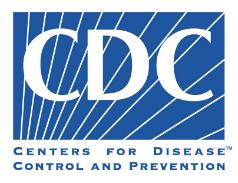
New Features of OneEdits2015
Landline and Cell Phone survey in one software survey in one
Includes a feature that allows ‘Resume Editing’ ‘Resume Editing’
Allows Users to “Hide Errors” Hide Errors
––Help in temporarily suppressing errors (avoid crowding) to focus on other problems on other problems
––Can be reactivated
Global field value replacement field value replacement
––Value of a particular field across the dataset can be replaced in one action
Appropriate error messages error messages
––Allows users to fix problems at their end users to fix problems at their end
Default Folder Structure
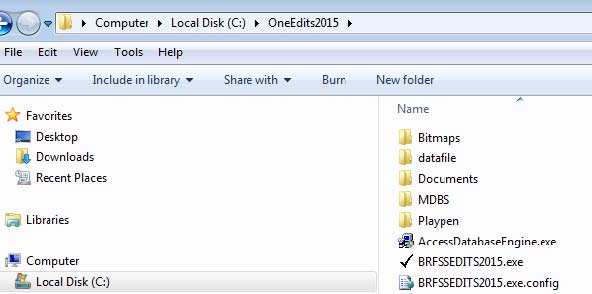
Datafile––Keep original .dattfile
Playpen ––OneEdits keeps duplicate file there and make changes there duplicate file there and make changes there
Select Survey
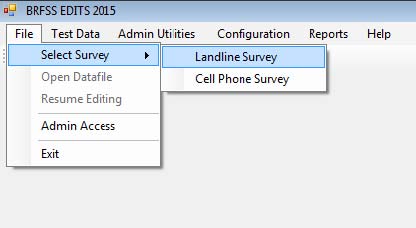
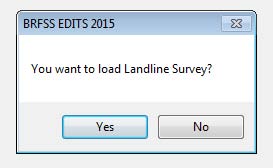
Select data file
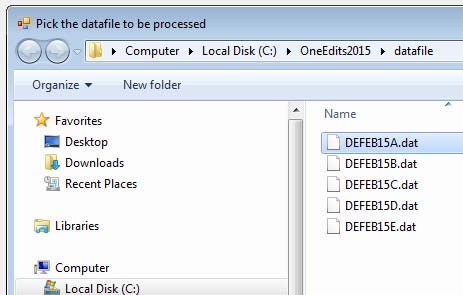
Select file from Datafile folder
Save selected data file….
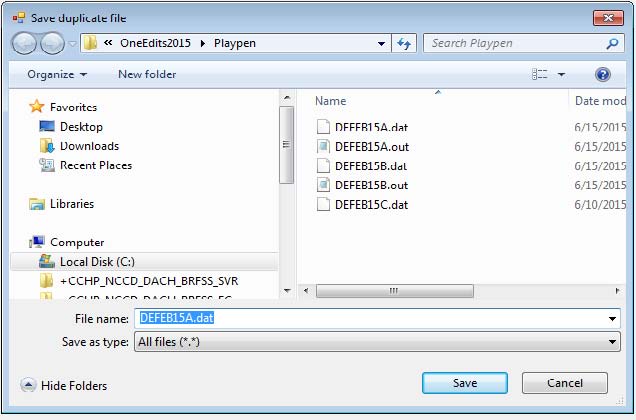 Save
selected file in playpen folder. Keep filename same as original file.
in playpen folder. Keep filename same as original file.
Save
selected file in playpen folder. Keep filename same as original file.
in playpen folder. Keep filename same as original file.
Screening Results ….
Basic screening run results, good place to verify if selected modules have data.ve data.
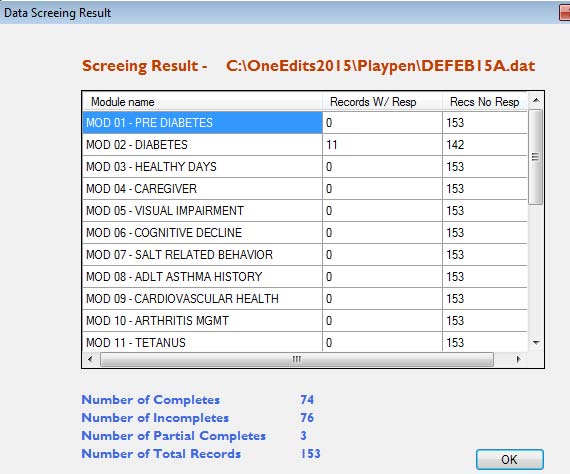
Screening Results ….
Test Dataset T--> Run Edits menu would run edits on selected dataset.> Run Edits menu would run edits on selected dataset.
Good place to review modules being run and see if that matches with what state intended to collect. state intended to collect.
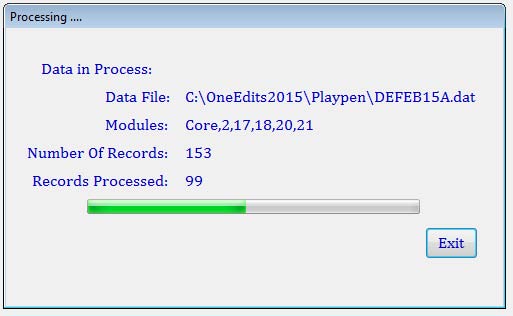
Edits Result ….
Test Dataset --> View Data menu would show edits run results. Data can be modified here in real time. Data can be modified here in real time.
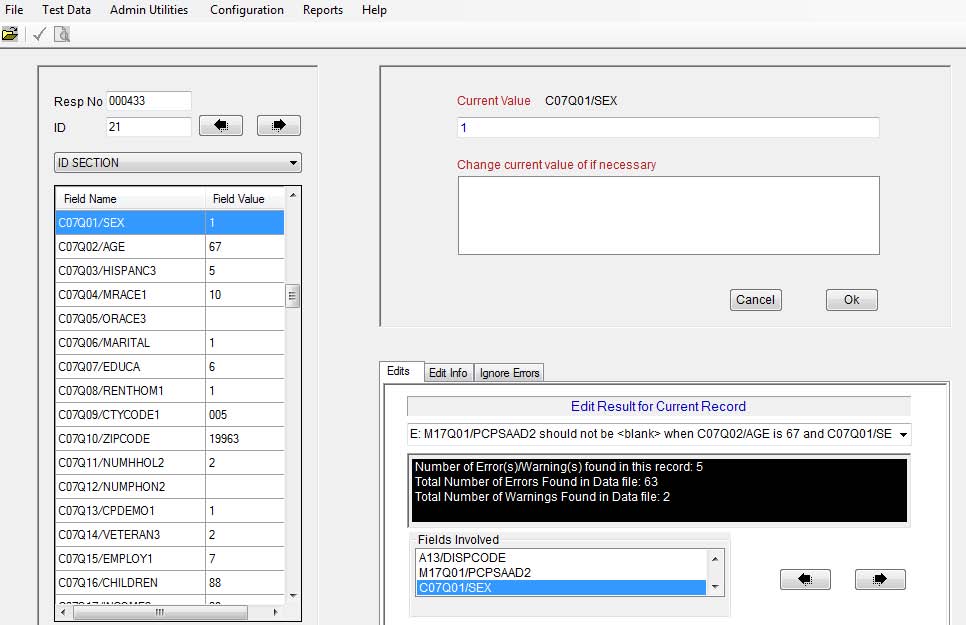
Ignore Errors….
This is where repeating errors can be suppressed temporarily to focus on other errors.
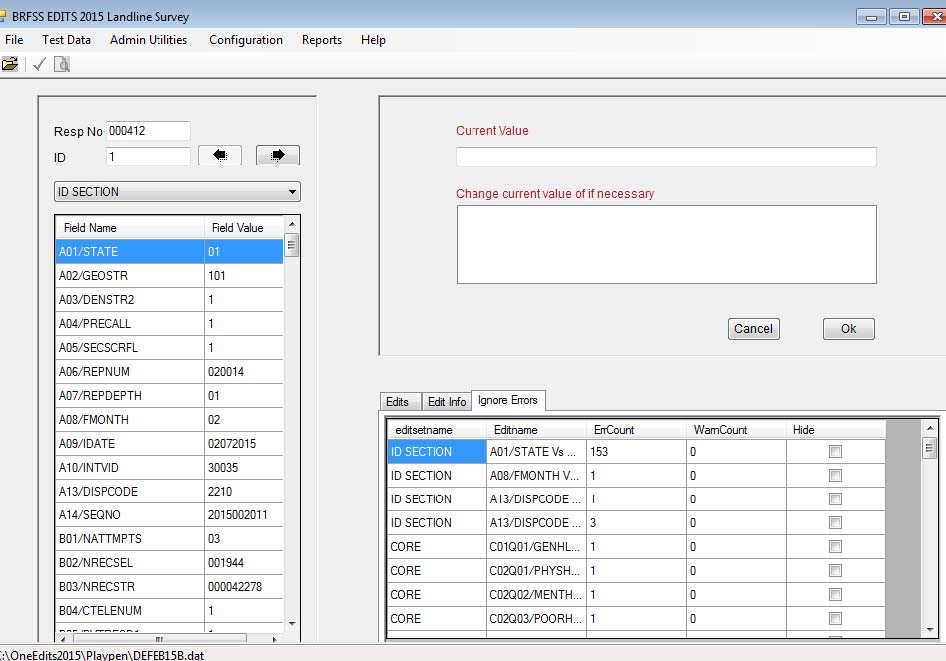
Resume Edits….
Select ‘No’ while quitting application if user
wants to resume editing in future.
File --> Select Survey and File --> Resume Editing would allow > Resume E resumption of editing.
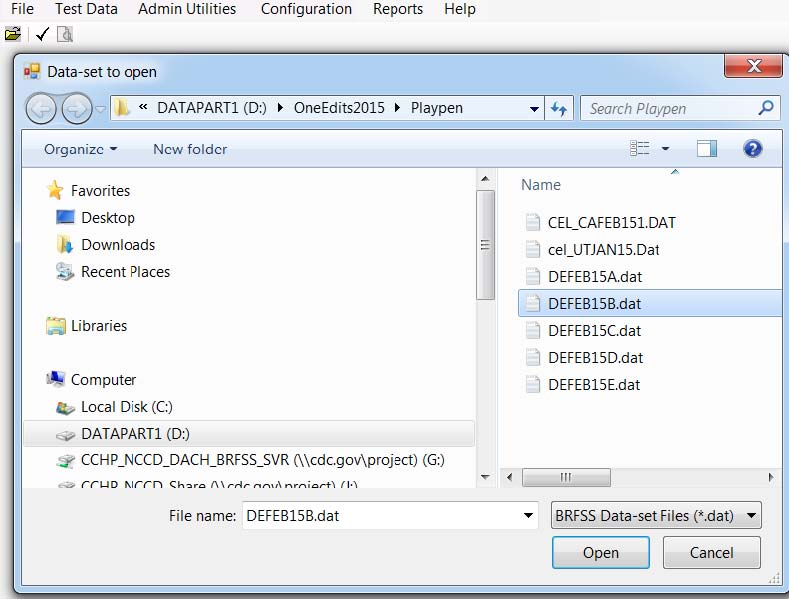
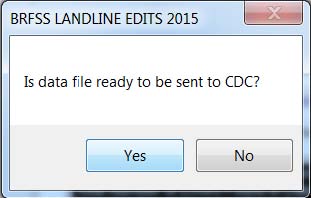
F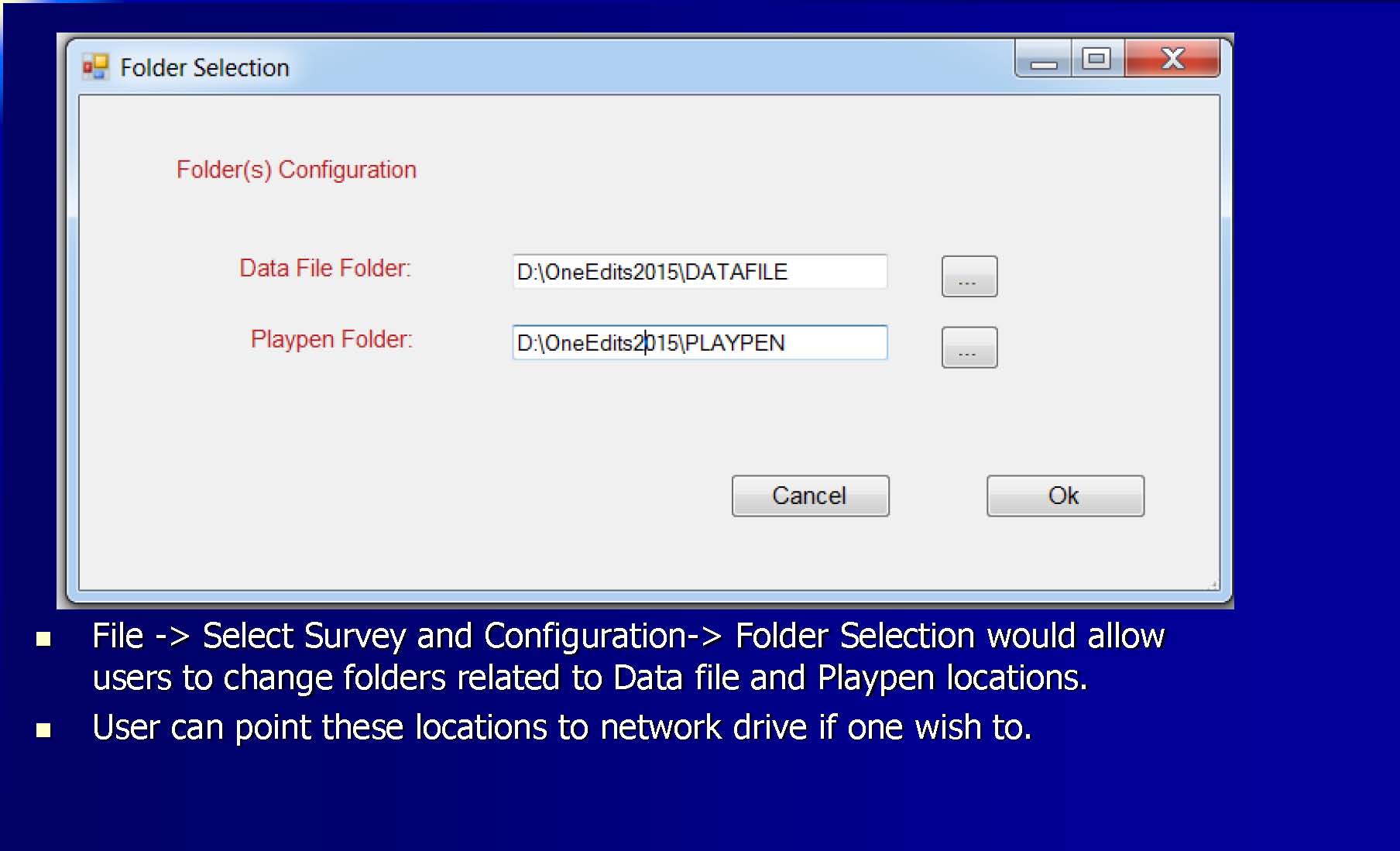 ile
-->
Select Survey and Configuration
ile
-->
Select Survey and Configuration
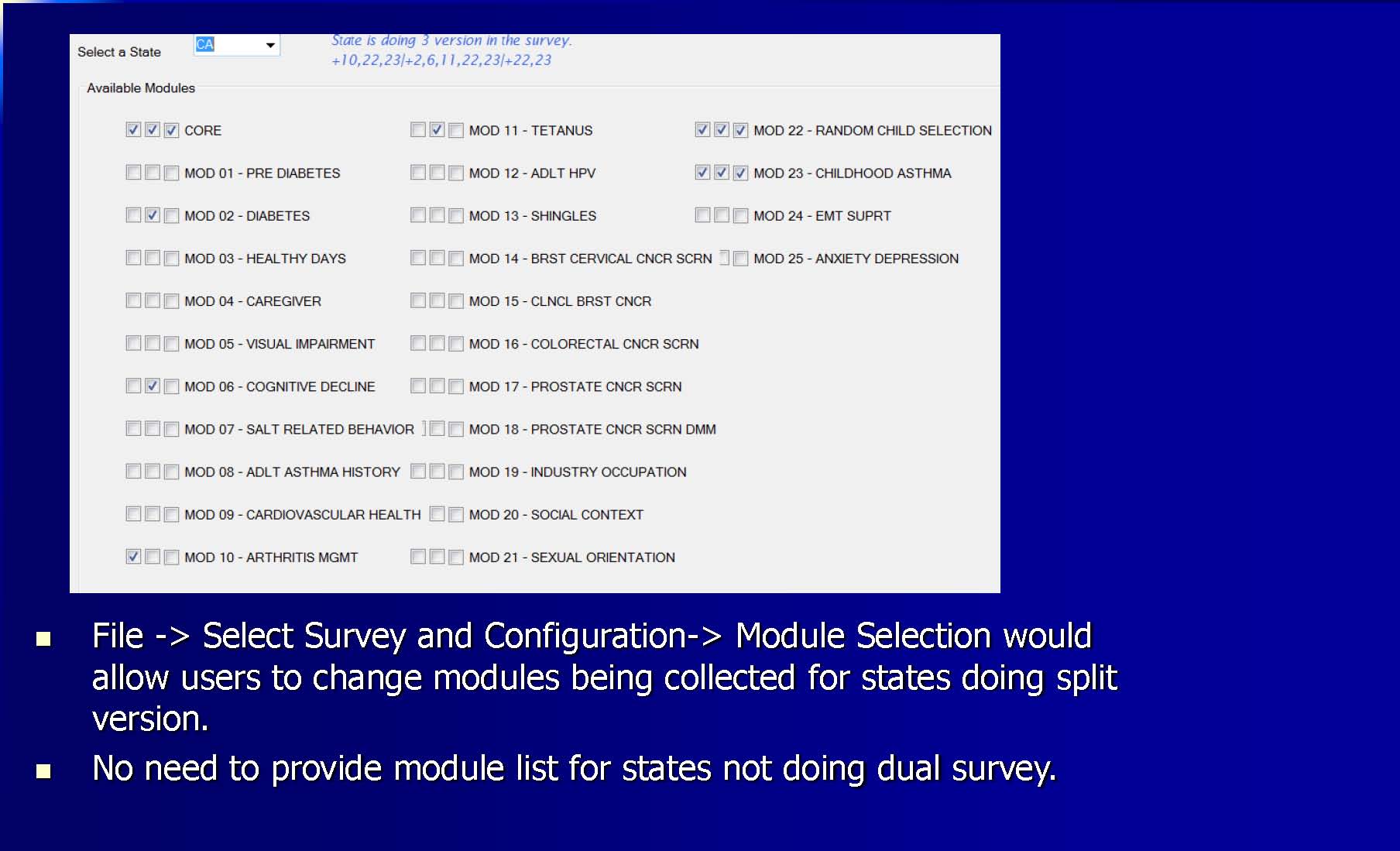 odule
Selection….
odule
Selection….
F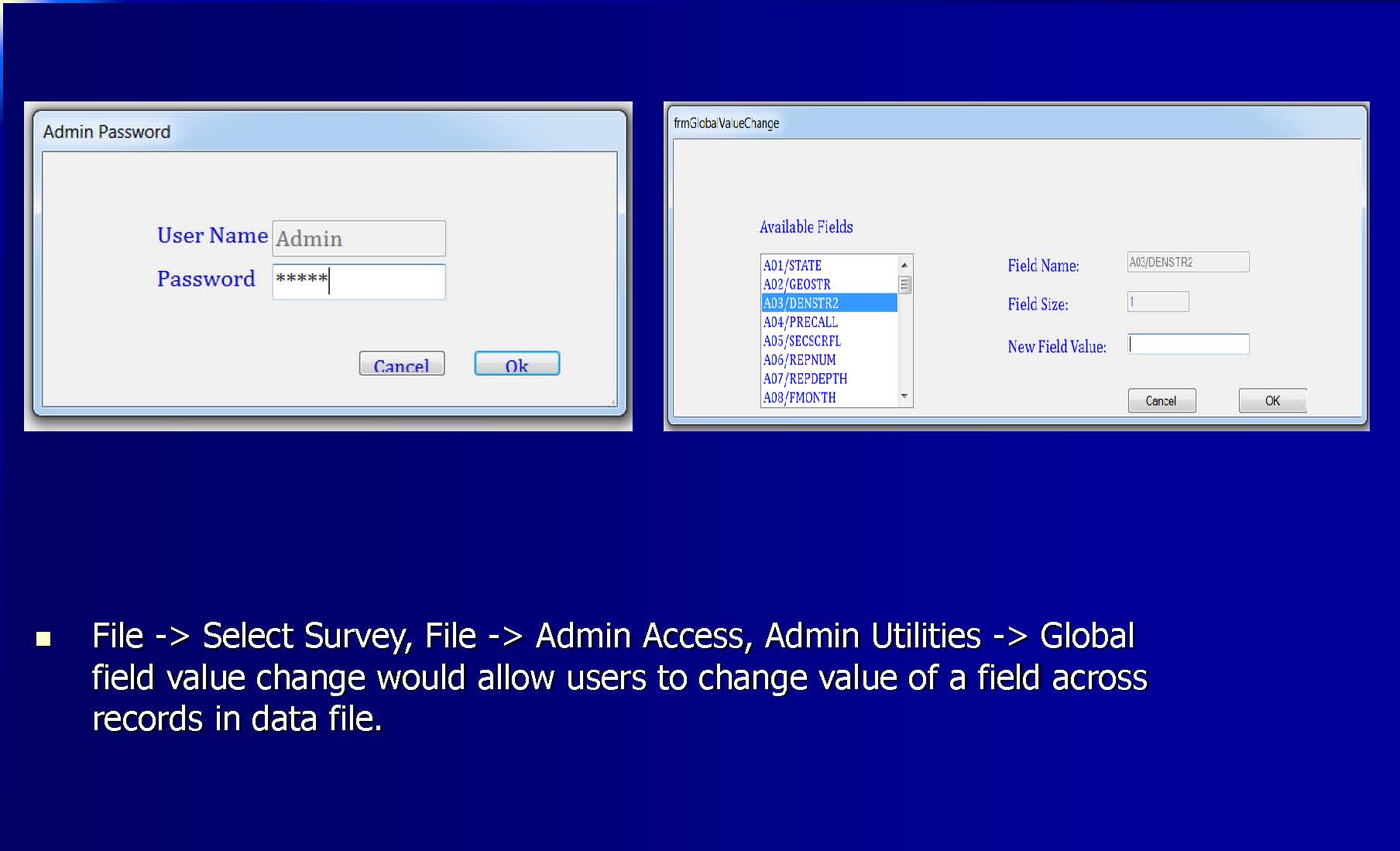 ile
-->
Select Survey, File -->
Admin Access, Admin
ile
-->
Select Survey, File -->
Admin Access, Admin
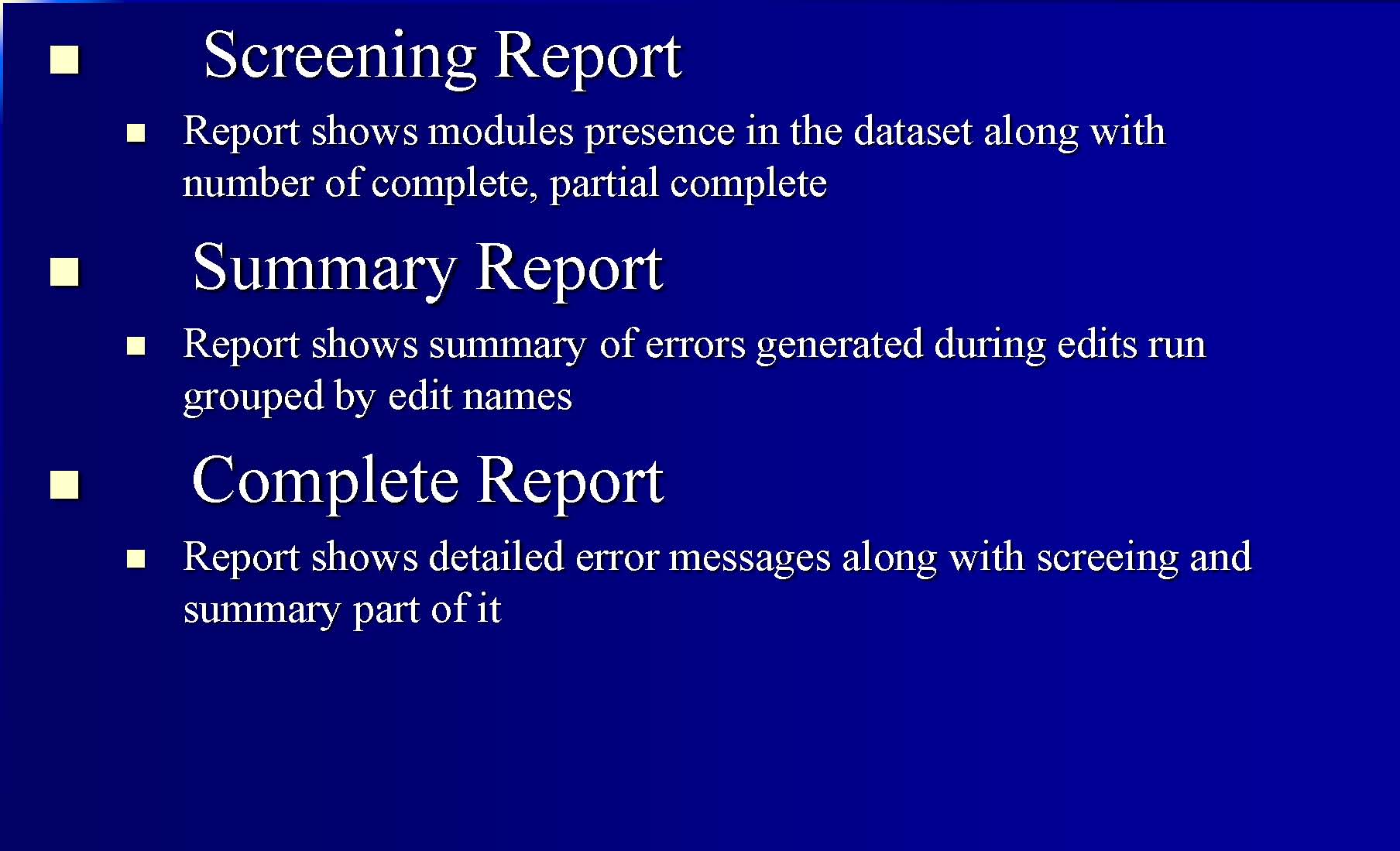 eports
…
eports
…
Error Messages
This message will show up if selected data file has missing data for any one of the fields mentioned in error message.one of the fields mentioned in error message.

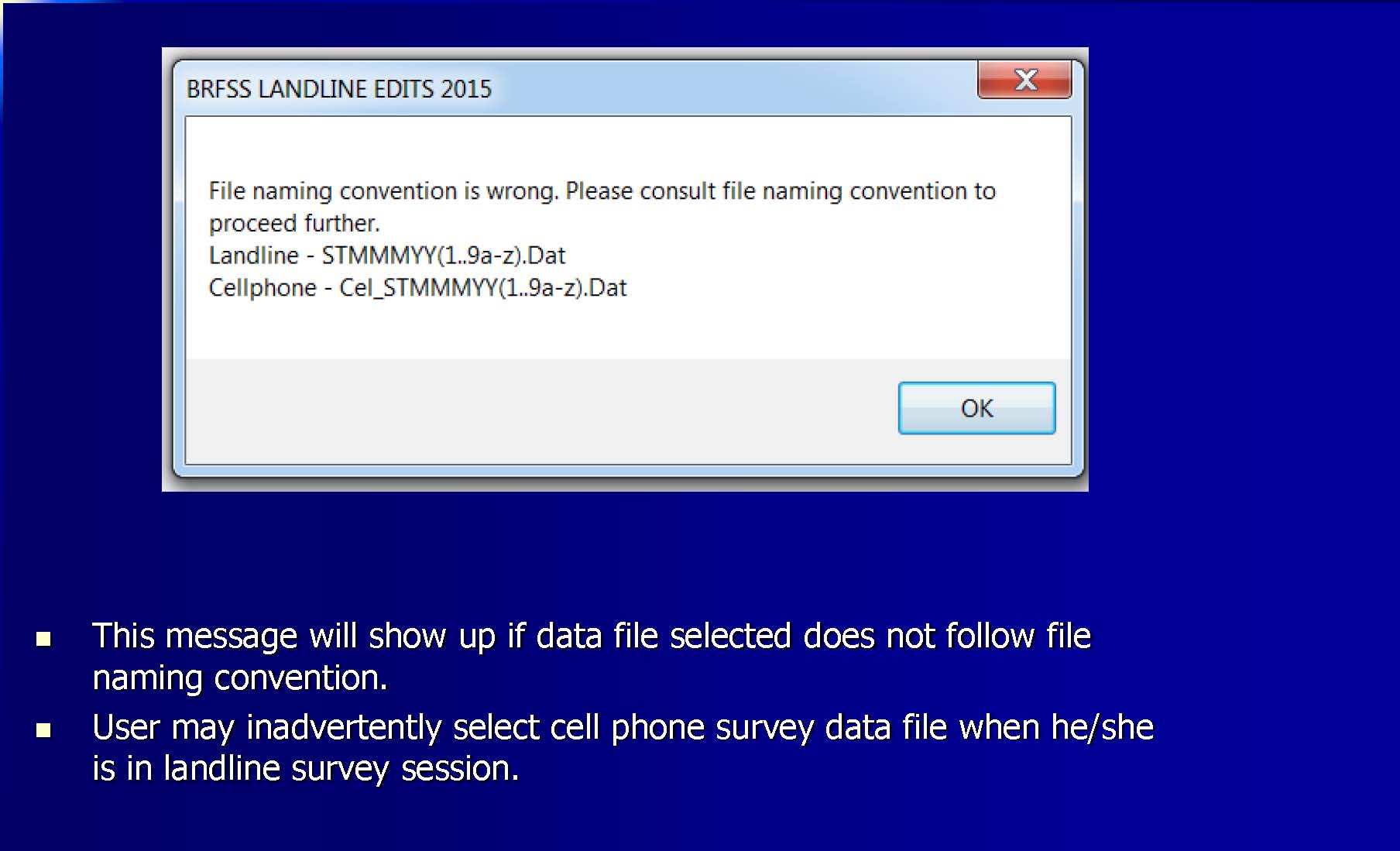
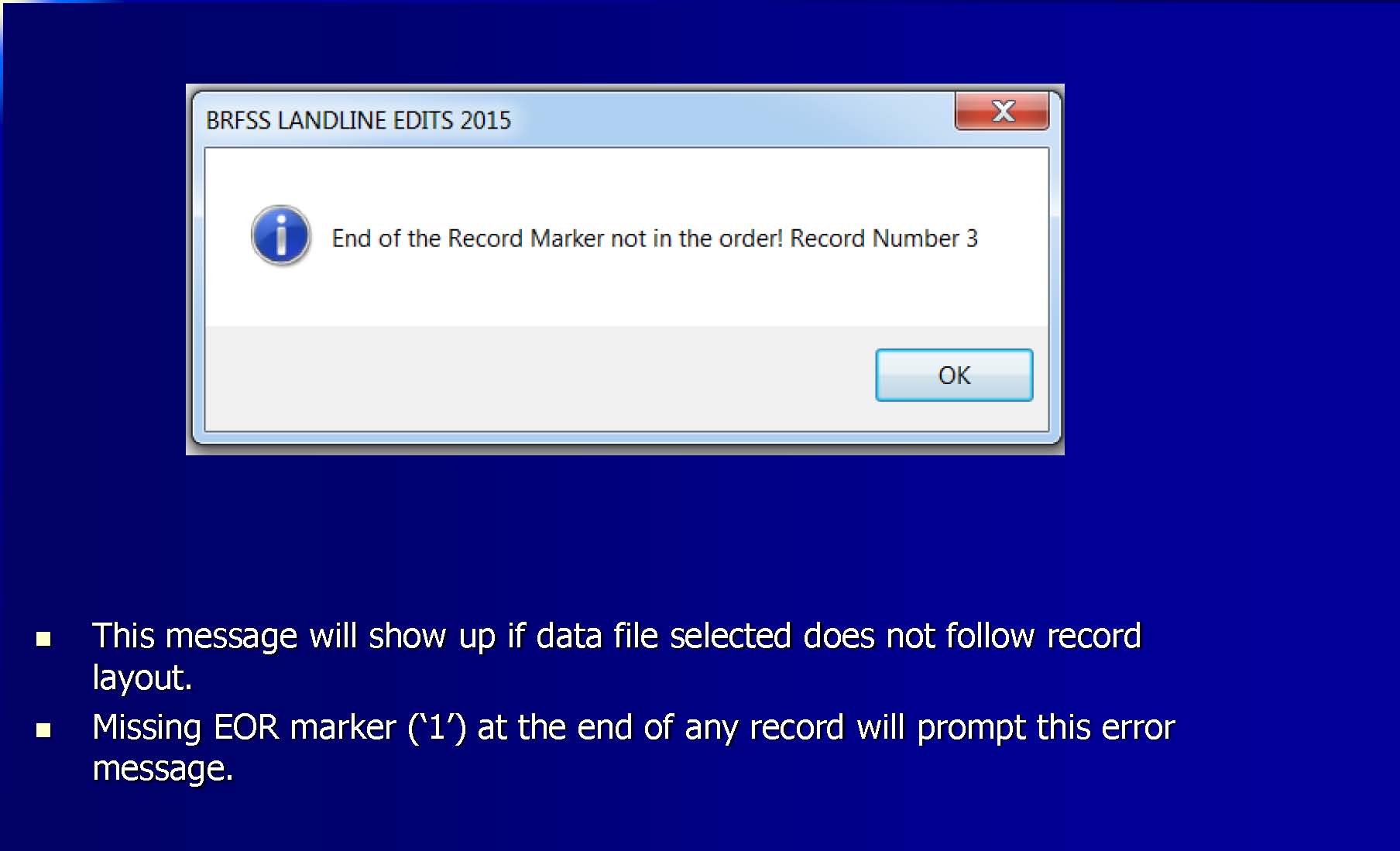
As with any software, there may be unexpected errors.
If you continue to experience problems with OneEdits, please contact Ajay Sharma [email protected] or Bill Garvin [email protected].
Page
| File Type | application/vnd.openxmlformats-officedocument.wordprocessingml.document |
| Author | CDC User |
| File Modified | 0000-00-00 |
| File Created | 2021-01-24 |
© 2025 OMB.report | Privacy Policy